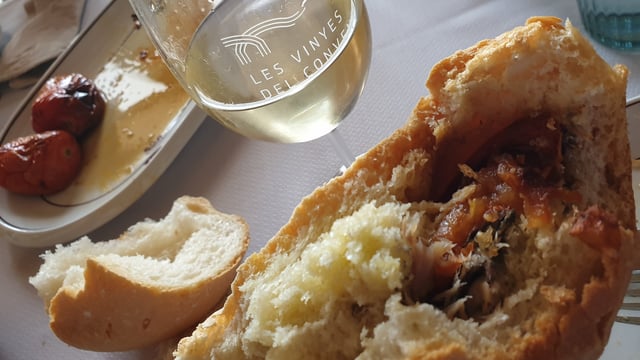Sometimes the simplest of dishes made from the basic of ingredients are the most satisfying. Often they are the most healthiest. This is certainly the case for the Clotxa from southern Catalonia. Today’s chefs are reviving this once traditional farmers’ meal, and making el bocata de los bocatas, the sandwich of sandwiches, their own. During a recent trip to Horta de Sant Joan, following in the footsteps of Picasso, I got the chance to make clotxa myself.
- Thomas Dowson
- Last Checked and/or Updated 9 December 2023
- No Comments
- Spain
Pablo Picasso is said to have declared that everything he knows he learned in Horta. A bold claim given he only visited the southern Catalonian village twice, briefly. At the age of 16 he came to Horta to recover from an illness; he arrived in the summer of 1898 and left the following February. Ten years later he visited again, from May to August in 1909.
A hospital built in 1580 has been transformed into the Centre Picasso; a homage to the artist and his time in Horta. Also, it is possible to tour the village and see the sites associated with Picasso, where he stayed and what he painted.
One of his subjects was the strikingly picturesque Santa Barbara mountain with the very well preserved monastery of Saint Salvador d’Horta at the base. The monastery goes back to the time to the Templars, hence its somewhat austere appearance. In the two kilometres between the monastery and Horta are many fields of olive trees. Too vast and extensive for what I understand of as a grove of olive trees. Olive oil is a major industry in this region. And it was in a historic mill that still processes olive oil that I got to taste the oil, as well as making my lunch.

Clotxa Recipe
The cloxta, pronounced clo-cha, is said to originate of the Ribera d’Ebre region in southern Catalonia. Simple and easy to make, it is the meal that the farmers of the region would make at the end of their day in the fields. They were away from their homes, with only the bare necessities and the basic but very healthy ingredients at hand. And this is what they came up with. Every year in mid March the town of Mora d’Ebre in the Ribera d’Ebre region hosts its ‘Festa de la Cloxta’.
If you can not get to southern Catalonia, why not try making a clotxa yourself. It is a wonderfully simple snack or meal to create.
Ingredients for a Clotxa

First things first. You need a round loaf of bread with some good quality extra virgin olive oil. The bread should be crusty and sturdy.

Next up are a few grilled or roasted tomatoes and a whole bulb of garlic.

And the final ingredient, a grilled herring or sardine.
Because of the saltiness of the fish and the full flavour of the olive oil, I found I did not need to add salt or pepper.
Making the Clotxa
As hard as you might try, this is a ‘messy’ dish to create. You start by hollowing out the bread. Keep the soft bread to mop up the juices on your plate at the end.

Then you start filling the loaf with your ingredients. First, line the loaf with a few tomatoes by placing them in the hole and pressing them against the sides with the back of a spoon. Pour on some olive oil. Add some grilled garlic. Peeling each clove is just too fiddly. The best thing to do is to cut of the base of the clove, and with the clove between your thumb and index finger squeeze the soft garlic on to the tomato. Pour on a bit more olive oil. Break up the fish into edible bits. And add that to the cavity. Add more garlic. Drizzle more olive oil. Add more tomato. Keep filling the cavity to suit your taste until it is full. You could add some bread at the end.

Eating the cloxta is even messier than the making. Keep a plate under your bread to catch the dripping juices: tomato and olive oil flavoured with roasted garlic and fish. And the meal pairs well with a chilled, dry white wine.
While I was making this my first cloxta I kept thinking this would be nice with a few capers, perhaps some olives. On my first bite, which really is a lot like standing on the edge of a swimming pool and wondering how cold it is before you dive in, the thought of those other flavours disappeared. The simplicity of these basic ingredients is what makes this ‘sandwich’ so good.
I have made cloxta at home since. A few times. And yes, I did experiment with other ingredients, as I am sure many do. Vegetarians who do not eat fish will want to replace the herring. And of course there are many suitable alternatives, such as a robust full flavoured cheese.







